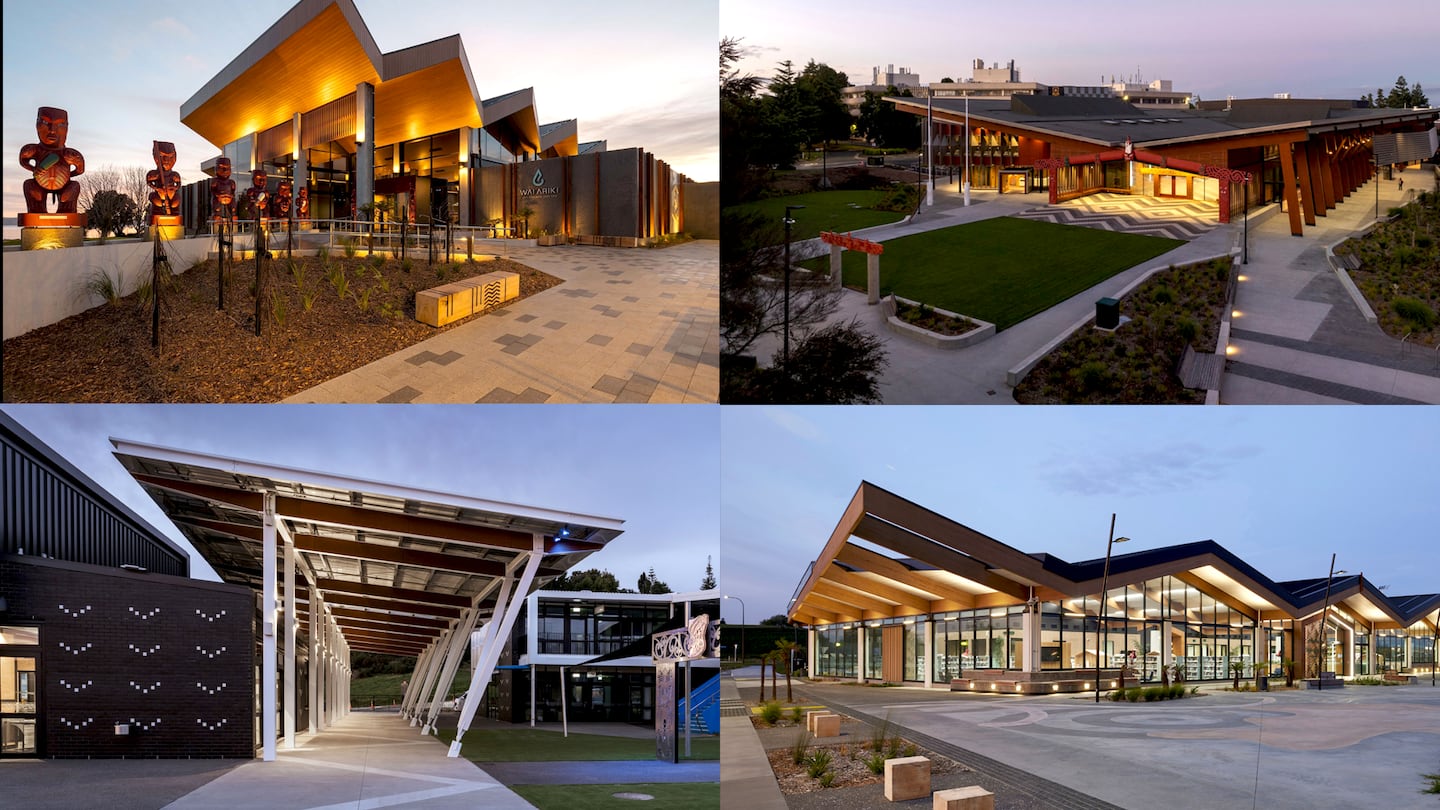A luxury spa in Rotorua, a community centre at Waikato University and a kura were among the 29 award winners in the 2024 Waikato and Bay of Plenty Architecture Awards.
The awards jury convenor and architect Matt Grant told the Bay of Plenty Times the jury was impressed with the quality of the work and the “rich environment” the Bay of Plenty offered, including beaches, lakes and rivers.
Grant said the judges were impressed by the presence of te ao Māori in projects in many categories. Wai Ariki Hot Springs and Spa, Te Rito O Manaaki Ora (a kaupapa Māori service provider in Rotorua), Te Kura o Manunui (Brookfield School in Tauranga), and Hamilton Kirikiriroa Airport were among the winning projects, imbued with a deep sense of Māori culture and design.
Te Rito Manaaki, Rotorua
0 of 6
Werner Nauda from DCA Architects says they worked closely with mana whenua who spearheaded the idea of having a “vertical marae”.
“So you enter into the building at the ground floor as the waharoa, then you go to the first floor which is the whare waananga, and then the second floor is te wāhi o ngā ringa wera, so it’s about having a place where everyone can be comfortable in a Māori kaupapa.”
The Pā, University of Waikato
0 of 5
The Pā is the new landmark building for students, staff and the wider community, to strengthen the university’s ability to engage with and deliver community events and activities.
Designed by architectural firms Jasmax, Architectus and DesignTribe, the 7000sqm building, built by commercial projects contractor Hawkins, showcases structural timber in engineered wooden glulam beams.
The beams are the largest in the country and are made with timber from sustainably harvested plantation forests. They give The Pā its unique shape, framing its roofline or whakaruruhau.
“This is a unique environment in the world,” says the director at Design Tribe Rau Hoskins.
“It’s the first mainstream university that has adopted an indigenous gathering space as its heart. Se we are very cognisant that all around the indigenous world, we have brothers who struggle to be represented within educational environments.
At the heart of The Pā is the university’s new wharenui, Ko Te Tangata, the name carried over from the university’s motto. Developed for the university by the late Professor Te Wharehuia Milroy in the 1990s, the motto is now elevated and revitalised with a depth of meaning that ties together the artworks and cultural narrative of the space.
The $85 million development, which has been underway since 2019, includes a food court, social and learning space, and a dedicated space for community events.
Wai Ariki, Rotorua
0 of 5
RCG Architecture & Property director Andy Florkowski says Wai Ariki was a collaborative effort with Ngāti Whakaue and Te Pukeroa Orawawhata Trust with whom they have been working on various projects for the past 30 years.
“So there is a really rich history,” he says.
“We’ve helped them develop several commercial assets over the years and the Wai Ariki spa has always been an aspiration that they wanted to pursue to really draw on Rotorua’s rich spa and geothermal legacy, which stretched back over 600 years.”
Social director Alex Liang says that working on projects like Wai Ariki that incorporate tikanga Māori has added “another layer and richness” to his mahi in the space.
“It’s normal for us to look at the land and the history and so on but to incorporate te ao Māori in it, it’s just another thread that’s been woven into the building and it’s been very special for me.”
Florkowski adds, “I think it really strongly contributes to our national identity as well. These roles of these tourism spaces as well with these people coming to these spaces, it really gives a richness to their experience that they can take away with them.”
Kura Manunui (Brookfield Primary), Tauranga
0 of 6
Waikato and Bay of Plenty winners by category
Commercial architecture
- Te Rito O Manaaki Ora by DCA Architects of Transformation
- Bricks and Mortar by Edwards White Architects
- MADE by Edwards White Architects
- Wai Ariki by RCG and Pukeroa Oruawhata Lakefront Holdings in association
- Hobbiton Bagshot Row by Tilt Architecture
- Ibex Lighting by Wingate Architects
Education
- The Pā by Architectus, Jasmax and Design Tribe
- Te Kura o Manunui by ASC Architects
- Tauranga Boys’ College — New Teaching Block by Design group Stapleton Elliott
Housing
- Whareroa by Bossley Architects
- Matua Masterclass by Brendon Gordon Architects
- French Pass House by Christopher Beer Architect
- The Chodge by DCA Architects of Transformation
- Coromandel House by Evelyn McNamara Architecture
- Lake Taupō House by RTA Studio
- Grace by Stevens Lawson Architects
- House on a hill by Stufkens + Chambers Architects
- Stud Farm Residence by Sumich Chaplin Architects
Housing - alterations and additions
- He Iti Ake by Architecture Bureau
Housing - multi unit
- Hills Residences by Edwards White Architects
Interior architecture
- Hamilton Kirikiriroa Airport by AWA Architects
- Baker Tilly Staples Rodway Fitout by Chow:Hill Architects
Public architecture
- Puna Kaukau o Te Oko Horoi — Perry Aquatic Centre by Architecture HDT
- Te Kete Aronui Rototuna Library by Chow:Hill Architects
- Hamilton Gardens, Ancient Egyptian Garden by Peddle Thorp Architects
Small project architecture
- Summerhill Pavilions ‘21 & ‘22 by Andrew Barrie Lab
- Whare Mīmīrū by Dr Anthony Hoete and Dr Jeremy Treadwell in association
- The Garden Room by Edwards White Architects
Enduring architecture
- Cranwell Place (1970) by Noel D’Arcy Blackburn

























